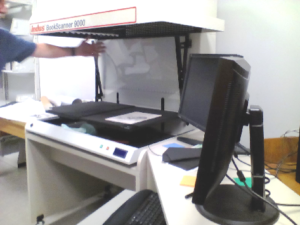This is part of a series of Session Notes from grantees who have received Professional Development grants from the Office of Commonwealth Libraries. Each grantee will share their professional development experience and include tips and other resources from the workshop or class. Grantees had their choice of an article for the Compendium, a webinar or a podcast. This project was made possible by the Institute of Museum and Library Services.
Recently, I was fortunate enough to attend a graduate level workshop called The Preservation of Library Materials in Columbus, OH. This two day, for credit, course offered by Kent State University helped me evaluate my own library more thoroughly and effectively. I believe the knowledge I gained from the reading materials and the instruction of Dr. Miriam Kahn, who works freelance evaluating libraries and teaches many workshops on the subject, could be useful to other library professionals.
Since my final paper assignment was to evaluate a library, I decided to share the criteria I used with my fellow Pennsylvania Librarians. The main areas for evaluation are: environmental conditions, book drops, shelving, library material handling practices, repair evaluation and methods, fire suppression and disaster plans. I will give basic guidelines for each of these topics.
Environmental conditions can greatly affect longevity of library materials. Different types of materials do better in different temperature ranges. Libraries must balance what is best for library items versus comfort levels for patrons. The article on paper and its preservation (see the source list below), recommended a range between 68°F and 72°F. Later sources continue to suggest this range. As we discussed in class, the exact temperature of the library is less important than consistency in temperature. Fluctuations of more than 2°F in a 24 hour period can accelerate the break down of glues and other bindings in books, leading to more broken spines. Along with temperature, humidity should be maintained as close to 45% ±2% as possible. A well maintained HVAC system is essential for sustaining consistent atmospheric conditions.
Dr. Kahn acknowledged the necessity for book drops, while bemoaning the damage they do to books and other library materials. Outside book drops subject items to extreme temperature and humidity fluctuations and, if emptied in rain or snow, excessive moisture. Receptacles that open directly into buildings pose a greater threat for bug or other vermin infestation as well as making the library more susceptible to vandalism from burning or otherwise dangerous objects thrown into the book drop. Both interior and exterior book drops can subject items to scratching from sliding down rough chutes and breaks from hitting the bottom and from other items landing on them.
The best libraries can do is minimize the damage as much as possible by cushioning the area where the items land, emptying as frequently as possible, and keeping them as clean as possible. Dr. Kahn recommends locking book drops during open hours so that patrons must return items inside. Also, instead of having a return book drop inside, devote more counter space for patrons to place returned materials.
Proper shelving plays a role in book preservation. Dr. Kahn backed up Barbara Higginbotham and others who recommend coated metal shelving that is secure, yet allows airflow. The Library of Congress weighs in on the subject on the online Preservation Frequently asked questions page:
When purchasing new shelving, metal shelves, are preferable over wood shelves because the acids present in wood can migrate into paper and books and cause deterioration.
Existing wood shelves that cannot be replaced can be lined with a barrier such as polyester film, corrugated polyethylene or polypropylene board, metal foil laminate, acrylic sheet, or glass, to prevent books from coming into direct contact with the wood.
Shelves should have a solid top to help protect against dust and water leaks. Books should be positioned roughly an inch from the front of each shelf with space behind. They should be upright with spines facing outward and spaced close enough together to keep them from tilting, yet not so tightly that the book is damaged when someone pulls it from the shelf. Nonskid bookends with no exposed metal touching books can aid in this. Dr. Kahn’s manual and the Susan Swartzburg book have additional guidelines for CDs and other common library material types.
Library staff and volunteers must model proper handling of library materials. If patrons see a library worker dropping books or otherwise handling them roughly, they will devalue the importance of taking care of anything in the library. Books, CDs, DVDs, and all other circulating and non-circulating holdings should be treated with care as standard practice, both as a part of direct preservation and to demonstrate that everyone should do their best not to cause unnecessary wear and tear. One often overlooked aspect of this is using sturdy book trucks with materials arranged so they will not slide or fall off during the shelving process.
Circulation staff and volunteers who regularly handle circulated items should be trained to identify anything in need of repair. No one should attempt repairs unless he or she has had proper training. Some larger libraries have personnel whose primary function is to repair books and other materials. For smaller libraries, the person or people responsible for this likely have many other duties. No matter the circumstances, great care should be taken to not further damage any item. Only non-acidic adhesives should be used, such as specially made tapes and glues. Ultimately, a librarian must decide whether replacing an item, especially if an exact match is readily available, is less expensive than the materials and paid staff time required to fix it.
The topic of emergency planning could warrant another entire paper. While we barely touched on the topic during the workshop itself, Dr. Kahn stressed the importance of having a well developed emergency plan. This plan includes both prevention measures, such as properly storing flammable materials and specialized storage for rare or brittle library items, and readily available, prioritized agendas and contact lists in case the worst should happen. The Judith Fortson book had much information for disaster planning, but Dr. Kahn’s published manual on the subject was more up-to-date and easier to follow. Both sources explain the pros and cons of different fire suppression systems and the efforts needed to create an emergency plan.
One last subject we read about and discussed was digitization. Some people have asked why we should even bother with preserving old, brittle printed materials when they can be digitized. Many assume storage and maintenance of electronic files would be much more economic and less time consuming than preserving items in print format. The Neil Grindley article in particular showed that the truth is the opposite. Articles by Suzanna Conrad and Melena Ryzik contributed to our debate on whether digital formats can be preserved as easily or as long as physical documents, books, photographs, and other types of materials, even older one in somewhat fragile condition.
Many larger libraries have begun transferring collections to digital formats, which can increase accessibility, at least of content. With ever-changing file type formatting and variability of website addresses, among other considerations, organizations often spend more money on software and IT personnel than they would spend on storage with optimum atmospheric conditions. If the electronic file is owned by another organization, one must also factor in licensing fees. For those institutions large enough and well funded enough to purchase the specialized equipment to scan or otherwise convert their rare or special items into digital formats (see picture after the source list), money must be budgeted for staff to run them. Specialized researchers who draw information from types of materials used and other aspects only gleaned by examining the original are not helped by digitization.
I hope this overview of what I learned from this workshop and its required readings gives you a better understanding of preservation issues and best practices. Dr. Kahn’s enthusiastic and peripatetic teaching style made the experience both educational and fun and I recommend her to anyone interested learning more about book repair and preservation. She can be contacted through her website.
Books and other written sources listed below contain additional insight into the various topics I introduced.
Source List
Conrad, Suzanna. “Analog, The Sequel: An Analysis of Current Film Archiving Practice and Hesitance to Embrace Digital Preservation.” Archival Issues 34 no. 1 (2012): 27-44
Dewey, Caitlin. “Gambling with your online memories.” The Washington Post (Feb 18, 2015)
Fortson, Judith. Disaster Planning & Recovery. NY: Neal Schuman, 1992
Grindley, Neil. “What’s the Cost of Curating Content in the Digital Age?” JISC BLOG (April 1, 2015)
Higginbotham, Barbra Buckner and Judith W. Wild. The Preservation Program Blueprint. Chicago, IL: ALA 2001.
Kahn, Miriam B. Disaster Response and Planning for Libraries. Chicago, IL: ALA 2012.
Managing Preservation: A Guidebook State Library of Ohio and Ohio Preservation Council 1995.
“Paper and Its Preservation: Environmental Controls in Preservation Leaflet No. 2”, A National Preservation Program Publication, October 1983
Ryzik, Melena. “When Artworks Crash: Restorers Face Digital Test.” New York Times Arts Section (June 9, 2013)
Swartzburg, Susan. Preserving Library Materials: A Manual. Metuchen, NJ: Scarecrow Press 1994.



